Key takeaways:
- Public speaking anxiety is a common issue, often tied to fear of judgment and mistakes, leading to physiological responses like voice shaking and tightness in the throat.
- Selective mutism is an anxiety disorder seen in children, where they cannot speak in certain social situations, often stemming from intense fear rather than mere shyness.
- Recognizing symptoms of anxiety, such as avoiding eye contact and inconsistent communication, is crucial for supporting those affected.
- Effective communication involves understanding the audience, using clear language, and practicing active listening to foster connection.
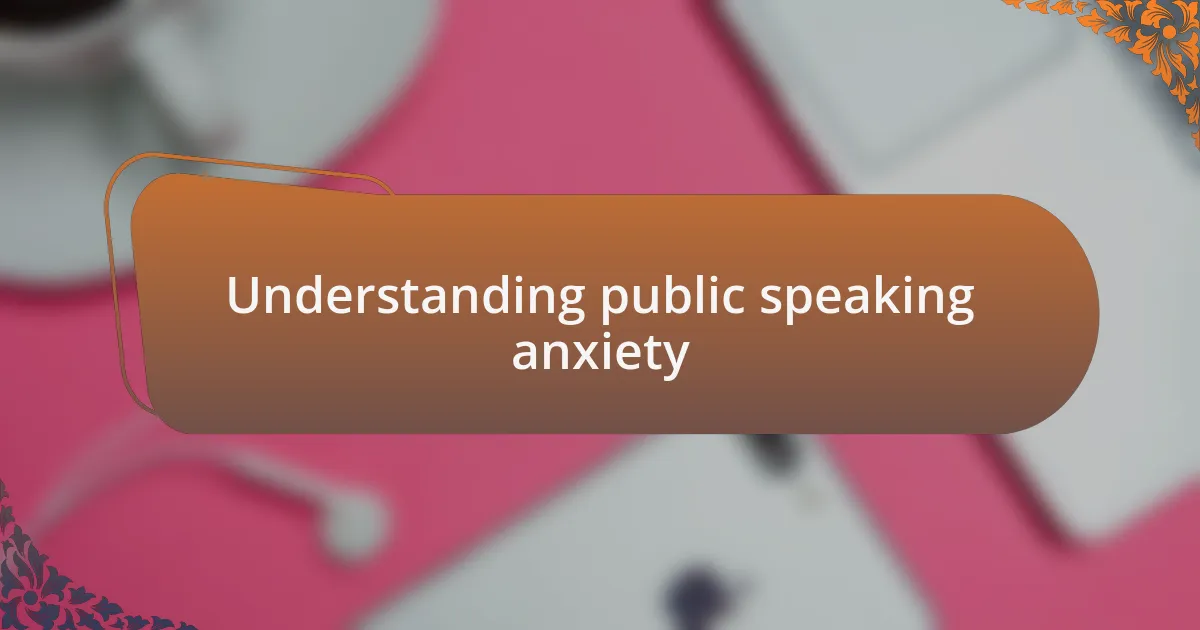
Understanding public speaking anxiety
Public speaking anxiety is a common experience that affects many individuals, regardless of age or background. I remember the first time I had to speak in front of my peers; my palms were sweaty, and my heart raced as I stood in front of that audience. Why do we have such strongly negative feelings about speaking publicly? It often stems from a fear of judgment or making mistakes, which can be overwhelming and paralyzing.
As I delved deeper into understanding this anxiety, I realized it often manifests as a fear of the unknown—what will people think? Will I forget my words? My journey taught me that these feelings are not just personal but shared by many. Reflecting on those emotions, I found a sense of camaraderie in knowing others experience similar fears. How empowering it can be to voice those common struggles!
The physiological responses to public speaking are fascinating as well. I used to feel my throat tighten and my voice shake, which only fueled my anxiety. This reaction is rooted in our body’s fight-or-flight response, designed to protect us but often makes the experience even more daunting. Acknowledging this natural reaction has helped me approach public speaking with a newfound perspective—seeing it as an opportunity to share rather than a battle to conquer.
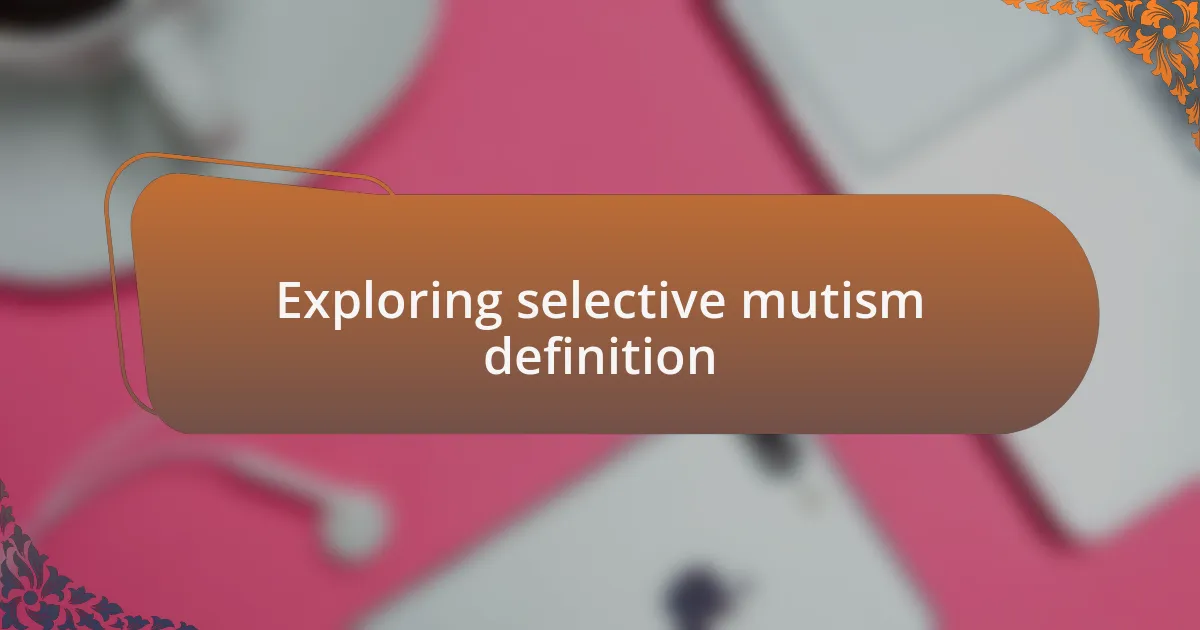
Exploring selective mutism definition
Selective mutism is a complex anxiety disorder primarily seen in children, characterized by an inability to speak in certain social situations, like school or public settings. I remember a classmate who would light up in casual conversations with us but become completely silent whenever the teacher called on her. It was perplexing because she seemed so confident among friends yet transformed in unfamiliar social environments.
The condition is more than just shyness; it can stem from intense fears or social anxiety that prevent the individual from communicating verbally. From my perspective, understanding this distinction is vital because it helps us recognize that those affected are not simply refusing to speak—they’re grappling with overwhelming feelings that hinder their ability to express themselves. Have you ever felt like words were stuck in your throat? For them, that’s often a daily struggle.
Over time, many children with selective mutism may find their voice through therapeutic interventions, gradually learning to cope with their anxiety. I recall hearing stories of kids who, slowly but surely, began to share their thoughts in safe spaces before branching out into larger groups. It’s a profound journey of healing, and it’s essential to provide supportive environments that nurture their progress without judgment.
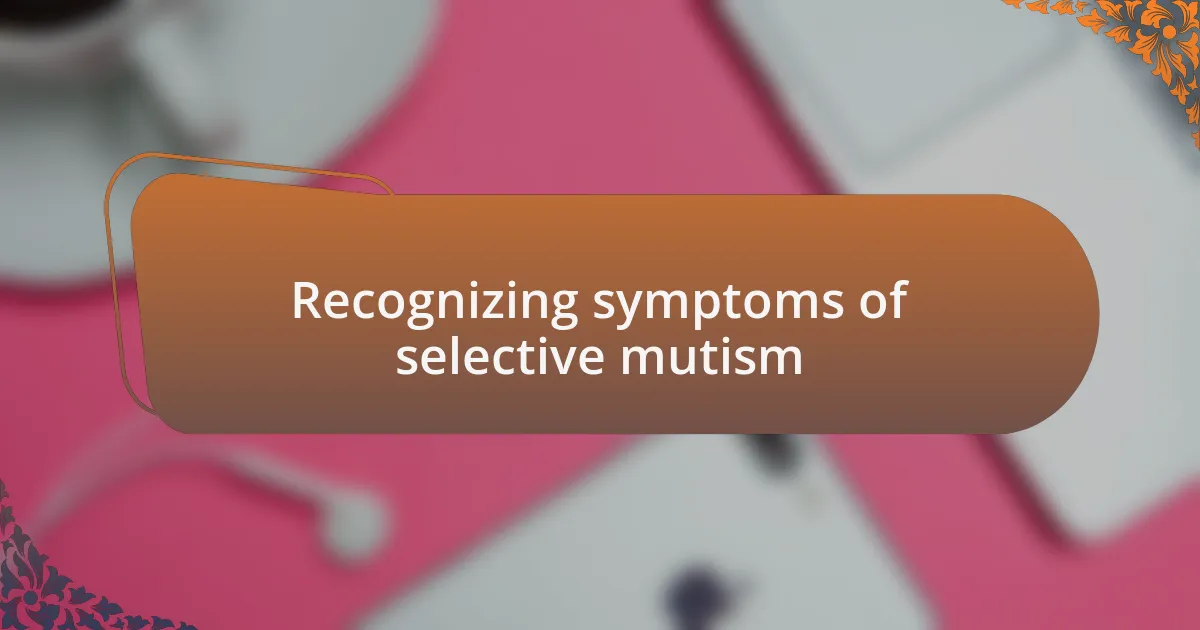
Recognizing symptoms of selective mutism
It’s often subtle, but recognizing the symptoms of selective mutism can make a world of difference. Many children may exhibit signs like avoiding eye contact or using nonverbal methods, such as nodding or gestures, to communicate. I remember noticing a friend who would clutch her backpack tightly and fidget with her fingers whenever we were in a larger group; it took me a while to understand that her silence didn’t indicate disinterest but rather anxiety.
Another key symptom is the inconsistency in communication. A child might freely chat with family members or close friends at home but suddenly freeze in social situations outside that comfort zone. This dichotomy was something I experienced firsthand when a neighbor’s kid could sing with gusto during family gatherings yet would not mutter a word at school. That stark difference often left me questioning what was behind the silence—was it fear, apprehension, or something deeper that kept them from finding their voice?
Physical symptoms also play a significant role in identifying selective mutism. Children may show signs of distress, such as a racing heart or sweating, particularly when faced with speaking requirements. It’s heartbreaking to witness, as I did with a relative who would blush and tremble at the mere thought of speaking in public. Have you ever found yourself feeling trapped in your own body? That’s what so many children go through, and understanding those signs can help guide them toward the support they truly need.
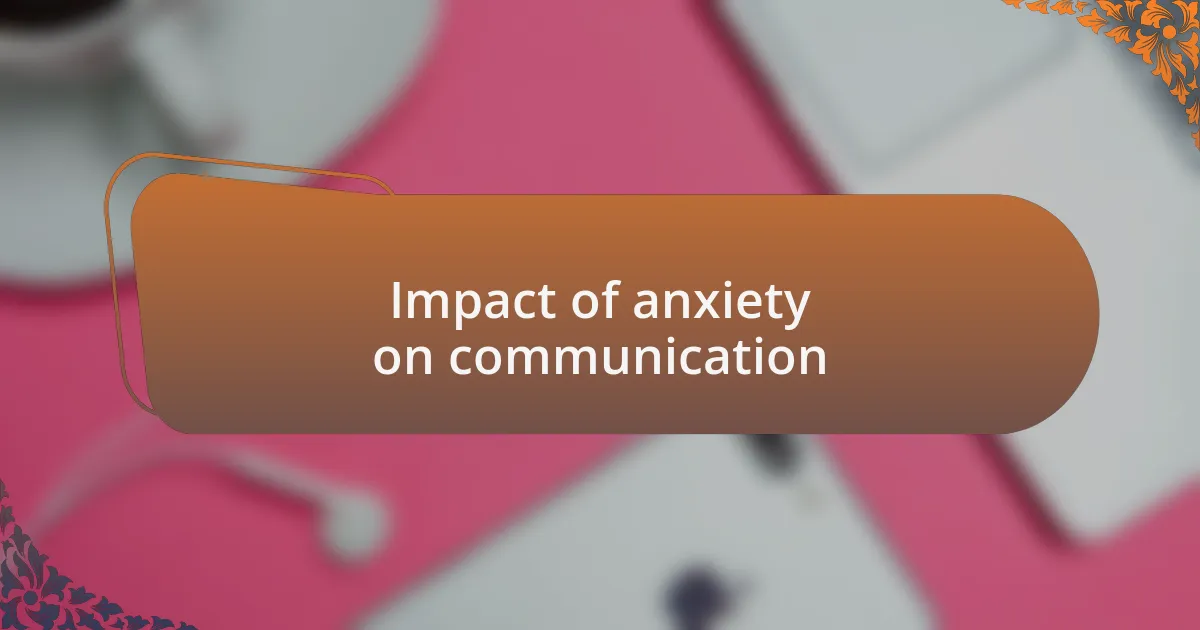
Impact of anxiety on communication
When anxiety creeps in, communication often takes a backseat. I recall standing in front of my classmates, heart racing, struggling to form even a simple sentence. The fear of judgment turned each word into a monumental task, as if the very act of speaking was a hurdle too high to clear. Have you ever felt your voice vanish when the spotlight is on you?
The impact of anxiety can manifest in many ways, significantly affecting one’s ability to connect with others. I once met someone who was charming and vibrant in small gatherings but became an entirely different person in larger groups. It was as if a cloud descended, dampening their spirit and leaving them isolated even in a crowd. This stark shift illustrates how anxiety can distort our communication abilities, making it difficult for individuals to express their true selves.
Moreover, anxiety not only hampers verbal communication but can also lead to a breakdown in nonverbal cues. I noticed that a close friend, usually expressive, started to close off, avoiding eye contact and fidgeting nervously with her hands. This change spoke volumes about her internal struggle and revealed how even the simplest expressions can be hindered by anxiety. It’s fascinating—and quite tragic—how such a profound emotional experience can silence our voices, both spoken and unspoken.
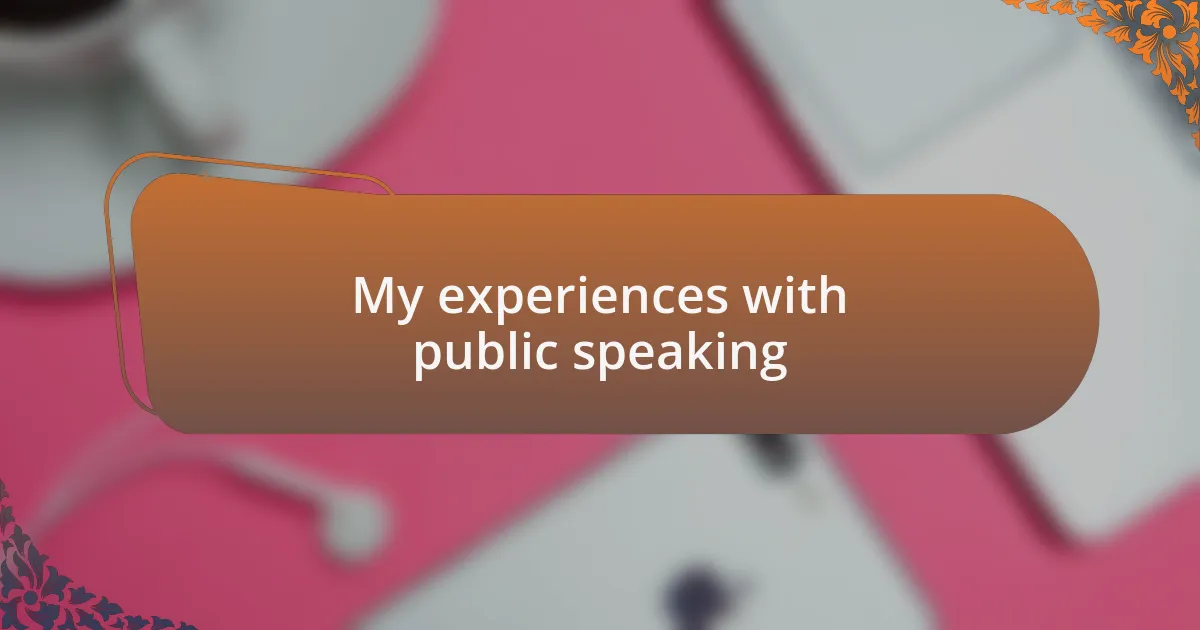
My experiences with public speaking
Standing in front of an audience always felt like standing at the edge of a cliff for me. I could practically hear my heartbeat in my ears, and the moment I opened my mouth, it felt like all eyes were drilling into my soul. One time, during a school presentation, I forgot my entire speech the instant I stood up—I just stood there, frozen, while my mind went blank. Has that ever happened to you? The feeling of vulnerability is hard to shake off.
I remember the first time I attempted to speak in public after years of avoiding it. My palms were clammy, and I could barely breathe, but I pushed myself to share my story. To my surprise, the audience responded with warmth, and their nods encouraged me. It’s moments like these that remind us that our fear can dissolve in the face of genuine connection and understanding.
However, the aftermath often left me feeling drained. I would replay the experience in my mind, critiquing every stumble and every pause. Did I sound foolish? Was I able to convey my message? These questions lingered, highlighting the inner turmoil that followed every public speaking experience. It’s a strange dichotomy—seeking connection while grappling with the fear of being misunderstood. How do you manage that balance when speaking publicly?
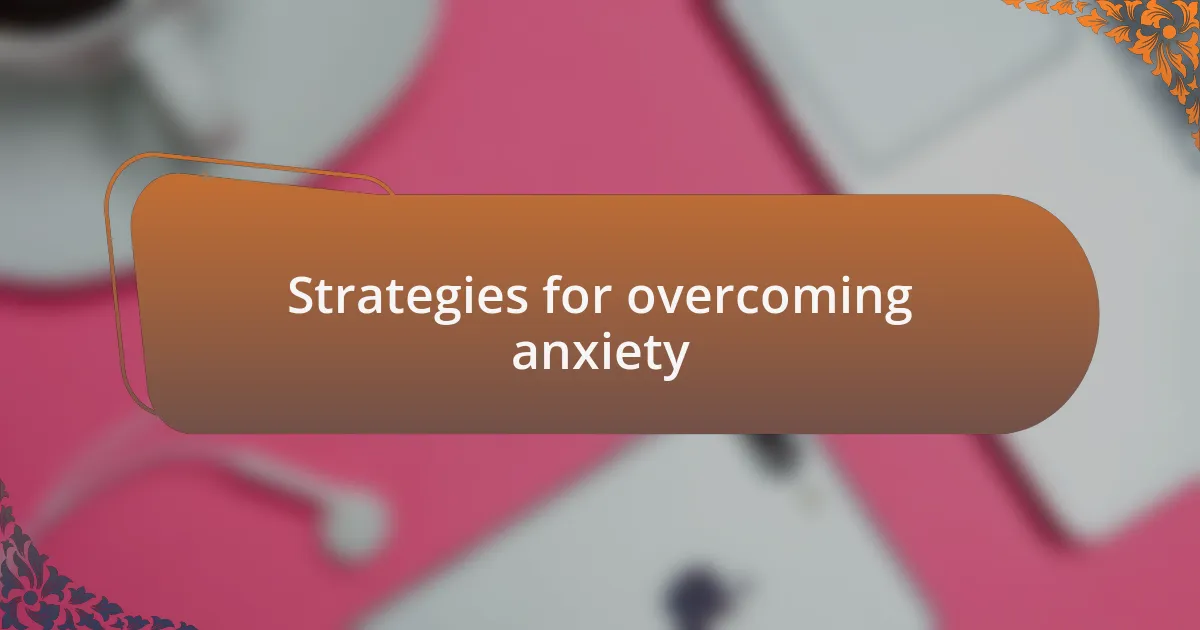
Strategies for overcoming anxiety
Finding effective strategies to overcome public speaking anxiety has been a transformative journey for me. One practical approach I discovered was visualization—before stepping onto the stage, I would close my eyes and picture myself giving a powerful presentation. This technique helped align my mind and body, easing the gripping tension that usually took hold of me. Have you ever tried visualization? It’s fascinating how shifting your mental landscape can reshape your real-world experience.
Breathing exercises also became my secret weapon. Just a few deep breaths before taking the stage grounded me and centered my thoughts. I recall one occasion when I used this technique just moments before a significant presentation. As I inhaled deeply, the anxious fluttering in my stomach subsided, helping me regain focus. It’s curious how something as simple as your breath can create such a profound shift in confidence.
Additionally, seeking feedback from peers has been invaluable. After each presentation, I would ask trusted friends for constructive criticism. Their insights, often highlighting what I did well rather than focusing solely on mistakes, encouraged me to see my growth. What if you opened yourself up to feedback? I found that acknowledging my progress, no matter how small, has helped me appreciate the journey of overcoming this anxiety.
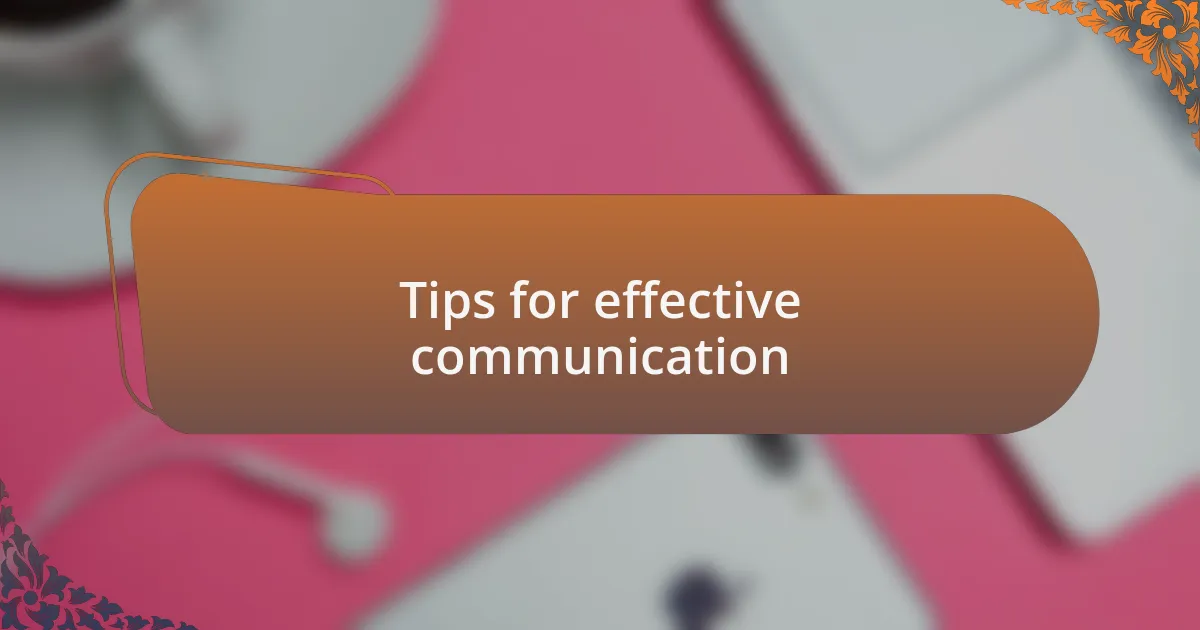
Tips for effective communication
Effective communication hinges on understanding your audience. During my early days of public speaking, I often focused solely on my content, missing the mark on connecting with those listening. I learned that engaging eye contact and attentive body language can create an invisible thread that binds speaker and audience together. Have you noticed how a simple glance can evoke engagement? It’s incredible how much we can convey without uttering a word.
Another key aspect of effective communication is clarity and conciseness. When I began to simplify my language and cut out unnecessary jargon, I noticed a shift in my audience’s receptiveness. During one of my presentations, I chose to express a complex idea with a relatable story instead of technical jargon. The result? A room full of nodding heads and smiles rather than confused faces. Didn’t we all appreciate when someone breaks things down for us?
Lastly, active listening plays an essential role in communication, too. I often found myself speaking without truly hearing questions or feedback from the audience. Once I started to genuinely tune into their responses, I could adapt my message in real time. It felt like a dance—my audience guiding me just as much as I was leading them. How often do we miss the rhythm of conversation by simply waiting for our turn to speak? By cultivating this habit, I’ve fostered a more inclusive environment that encourages open dialogue.